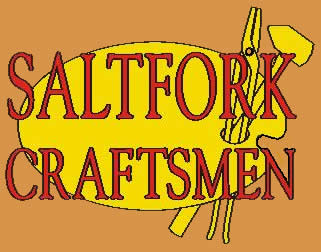
Artist-Blacksmith Association
Oklahoma Affiliate of ABANA
♦ July Newsletter
♦ July BW Newsletter
 |
Saltfork Craftsmen
Artist-Blacksmith Association Oklahoma Affiliate of ABANA |
♦ July Newsletter ♦ July BW Newsletter |
| Home | JOIN | Calendar | About Us | Contact | Projects | Library | Links |
| Workshops | Demos | Videos | Member Gallery | Newsletter | Scholarships | Tailgate | Membership Application |
|
If you are interested in blacksmithing, the first step is to network with others who have the same interest. This can easily be accomplished by attending one of the regional or state meetings of the Saltfork Craftsmen Artist Blacksmith Association. Their web site www.saltforkcraftsmen.org will list meetings and demonstrations in the newsletter, and on the website calendar. One thing unusual about Saltfork is the member's willingness to help newcomers get acquainted with all forms of blacksmithing, and their sharing of techniques, equipment availability, and supply sources. Like most any hobby, blacksmithing can be very simple or very complicated. Getting all the fancy tools up front, as you already realize, will cost a fortune and may or may not work out as you planned. I've seen this same thing in the antique car/street rod hobby. Many good buys of old cars come from those who jumped in big time and lost interest or ran out of $. Below are ideas to help you Keep Things Simple in blacksmithing. There are blacksmithing meetings or demonstrations on almost any weekend. In addition to the local organizations, there are conferences on a regional or national basis. You can even plan your vacation to take in a demonstration or a smithing conference. The national organization is the Artist Blacksmith Association of North America (ABANA). It is very beneficial to join ABANA to increase your exposure to outstanding work around the country. Go to https://www.abana.org; the ABANA publications alone are worth the cost. Second, buy or borrow some basic blacksmithing books. Many show how to make tools. The Internet is a good place to find used (inexpensive) books. Take a look at www.bookfinder.com. Check out the local library for books or videotapes about metal fabrication and smithing. Start slow in buying books; most cover the same basic information. Here are a few recommended books:
Third, keep things simple at first. Most blacksmithing tools can be made at home from scrap. Can you weld? No – get into your local Vo Tech welding class. You can learn to weld and fabricate steel there. Use their tools and equipment to make your blacksmithing stuff – forge, anvil stand, etc.
### |
| Support *Artist-Blacksmith's Association of North America |
 |
| The Artists-Blacksmith's Association of North America was established in 1973 and since its inception has played a major role in the recognition and resurgence of Artist-Blacksmiths in North America. | |
This site was last updated: 2025-6-30
Artist-Blacksmith Association